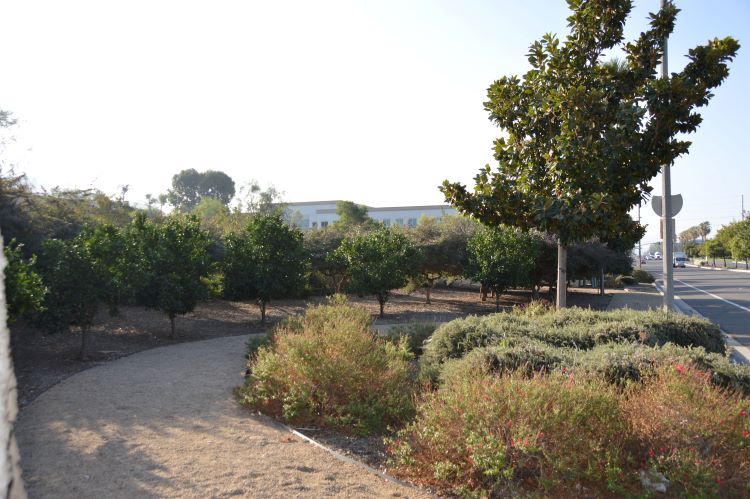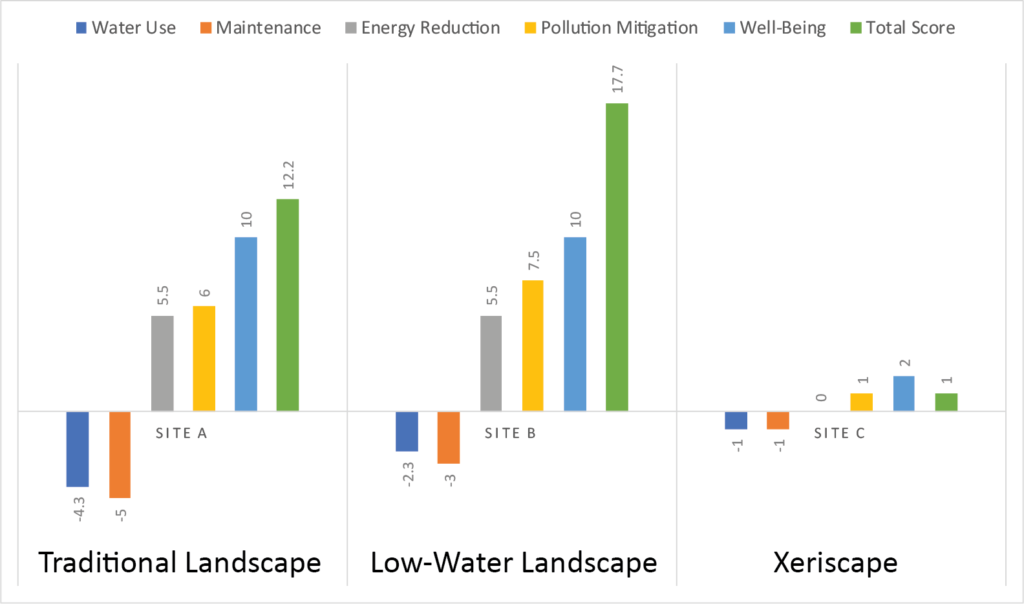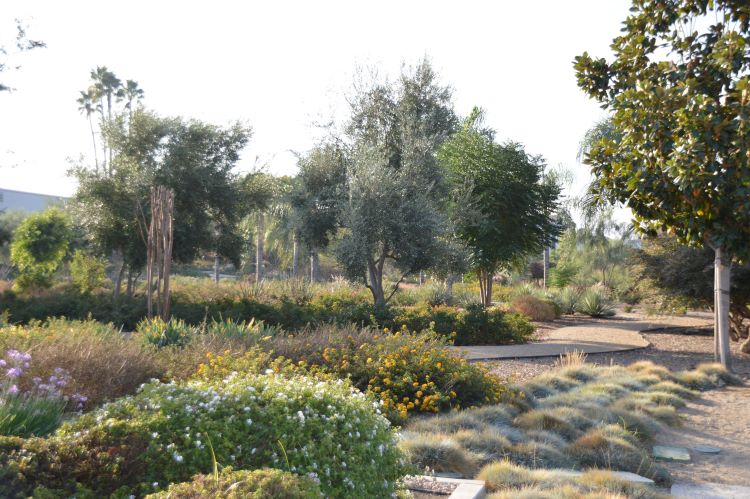Your Landscape is not the Enemy
Kay Kite | November 19, 2019

There is more to your landscape than water use and maintenance costs.
Ornamental landscapes have long occupied a unique part of our environment. Both background noise and central to our everyday experiences, they can enhance the aesthetic appeal of a site, raise property values, remove carbon dioxide (CO2) and other pollutants from the atmosphere, provide cooling on hot days, reduce stress, and many other benefits to the humans that tend to them. These landscapes come at a cost, however, in regular maintenance, CO2 emissions from these activities, and water needs. These costs are usually what a property owner focuses on and landscapes are often seen as an unnecessary nuisance.
The recession in the early part of the 21st century led to abandonment of many landscapes in southern California for monetary savings, while the recent droughts that swept through the southern and western portions of the nation brought critical attention to ornamental vegetation and the water needs it presented. A trend of removing plants for rock or other types of inert groundcover, commonly known as xeriscaping, began to gather momentum, especially in the drought-stricken areas. Those who have toured the industrial area of Corona, CA, in an effort to avoid the 91 freeway, or who have taken detours through the streets of Fresno, or Riverside, CA, have seen more and more xeriscaping replacing traditional landscapes. Is this transition as beneficial as claimed? Are there better alternatives? To answer these questions, I analyzed three different approaches to designing Southern California landscapes, comparing water use, maintenance needs, energy savings, pollution mitigation, and physiological well-being.

Three different designs for a hypothetical 1,000 square foot landscape are compared. Site A represents a traditional landscape of 30% turf and 70% moderate-water using plants. Site B contains 100% low-water use or native plants. Site C has 70% rock type ground cover and 30% succulent or low-water use plant cover. Comparing these three types of ornamental landscapes, a value on a scale from -10 to +10 is assigned to site for each variable analyzed, with negative values used for costs and positive values used for Benefits


Water Use
Water use is one of the largest quantifiable costs for any landscaped area. While there are many techniques available to help reduce the amount of water expended, drier areas such as southern California, need to supplement most plant material to keep a planted area meeting the aesthetic expectations of its caretakers. While rain capture or other water reuse devices lower the ongoing water costs, their initial installation costs and the growing unreliability of rainfall in drier states lowers the effectiveness at determining water savings, so are not considered in this analysis. Most city codes in Southern California require the use of mulches to reduce evaporation and minimum standards are set for irrigation efficiency. All of the sites are assumed to meet the current California landscape codes. Using standard water use calculations for the City of Riverside, CA, the annual water use for each site can be estimated (Figure 4). Site C has the lowest water use, so it is assigned a value of -1. The annual cost for water at Site A is 4.3 times that at Site C, so it is assigned a value of -4.3. Site B is only 2.3 times Site C, for a value of -2.3.

Maintenance
In order to meet municipal codes and popular preferences, maintenance of urban landscapes is required. For Site C, the maintenance is minimal due to permanent weed barriers, limited irrigation systems, and little plant material, for a value of -1. Site A includes costs for mowing, pruning, irrigation system adjustments, and leaf litter haul-off. A survey of various maintenance companies estimates this at $35 per square foot, approximately 5 times that of Site C, earning a value of -5. Site B is harder to quantify as it can be left mostly natural or pruned to resemble Site A. This analysis uses a value of -3.
Energy Use Reduction
Studies show that traditional and low water use landscapes provide energy savings for cooling through lowering temperatures and shading buildings. On the ground plane, bare dirt and rock surfaces have been shown to reach temperatures similar to those of asphalt while vegetation can reduce those temperatures by 20˚C. Variations in vegetation heights increases these cooling affects even further, putting Site C at a further disadvantage due to the vegetation usually being the same size with large spaces of flat features in between. Site C is assigned a value of -1 for increasing cooling energy costs due to reflected heat, while both Sites A & B receive a value of 5.5 for their calculated energy savings values being approximately 5.5x greater than having no vegetation.
Pollution Mitigation
Beyond the direct monetary value of a landscape is the ability to mitigate many different types of pollution. Trees are the best natural land-based pollutant mitigation element available. The most common measurement of this pollution mitigation is the removal of CO2 from the atmosphere. These values vary by tree and favor large, broadleaf, evergreen trees as might be found in Site A or Site B. However, the urban life cycle of trees also releases carbon. To break even with the carbon release, a tree must be healthy for the entire average urban tree lifespan of 15 years. Other vegetation within the landscape also sequester carbon and pollutants, but at vastly different rates. Broadleaf shrubs mixed with groundcover have a CO2 removal potential 6 times that of succulents or desert adapted plants. Beyond capturing carbon, plants prevent road pollution from blowing onto a site, reducing human exposure. Putting these all together, Site A has a mitigation potential of 6 times that of site C with minimal plant material. Site B show the greatest combined potential with shrubs, trees and groundcovers combining to mitigate 1.25x more than site A (Whittinghill, et. all, 2014). Based on this, the values assinged to each site are as follows: Site A=6, Site B=7.5, Site C=1.

Well-Being
The final, most intangible benefit of landscapes is their affect on human cognition and physiological well-being. There have been many studies showing landscapes aid in improving focus, reducing stress and aid in cognitive development of children. These studies specifically point to the foliage of the plants and the green colors viewed, indicating that site C would not be able to have the same effects. While harder to measure due to personal preferences, the lack of vegetation at Site C can be seen as less beneficial for a value of 2. Sites A & B can benefit different groups of people but still provide all of the benefits listed above in some way, so both will share a value of 10, with 2 points for the 5 non-measurable benefits noted.

While xeriscape strategies reduce costs in water and maintenance, their limitations in reducing energy consumption, removing pollutants, and contributing to physiological well-being are significant drawbacks that reduce their desirability. Traditional, moderate-water use landscapes are also not preferable due to their strain on resources. The low-water use or native landscape approach provides the best of both worlds, but the aesthetic appeal has not gained widespread acceptance, with stories of code compliance or home owner association violations for those that have tried to transition to a native landscapes. Even when native or low-water use landscapes are installed, the traditional view of heavy maintenance to prune and shape cancels out many of their benefits.

When looking at cutting direct costs or reducing headaches, many look at landscaped areas, but these areas provide many benefits that they may not be aware of. They are a friend, not an enemy.

Kay is a graduate student in the Master of Landscape Architecture program at Cal Poly Pomona. Her work focuses on water quality and conservation as a part of landscapes, as well as climate change resilience. She is a Certified Irrigation Designer and has over 20 years of work experience in the Landscape Architecture industry